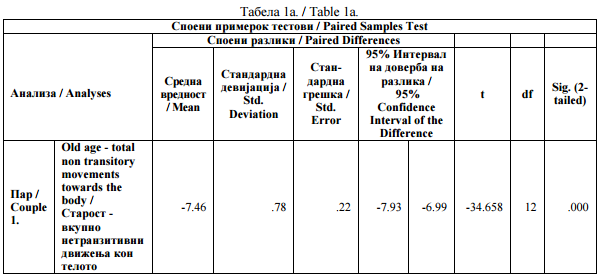JSER Policies
JSER Online
JSER Data
Frequency: quarterly
ISSN: 1409-6099 (Print)
ISSN: 1857-663X (Online)
Authors Info
- Read: 51575
|
ВЛИЈАНИЕТО НА МЕНТАЛНАТА РЕТАРДАЦИЈА ВРЗ МЕНТАЛНАТА РЕПРЕЗЕНТАЦИЈА И МОТОРНАТА ИЗВЕДБА
Факултет за специјална едукација и |
|
THE INFLUENCE OF MENTAL RETARDATION ON MENTAL REPRESENTATION AND MOTOR EXECUTION
Goran NEDOVIKJ
Faculty for Special Education and |
|
Вовед |
|
|
|
|
|
|
|
Дескриптивните описи на менталната репрезентација најмногу се поврзани со анегдотски содржини. По што темите од секојдневниот живот стануваат предизвик за размислување и истражување. |
|
Probably the most common descriptions of mental representation appeared as anecdotal content. After that, real-life content becomes challenge for consideration and research. Jeannerod, using a simple example, gives this explanation: “Motor ideas in relation to their representative action operate the same as a teacher and pupil do. For example, when the motor skills for playing an instrument are learned. The student observes as the teacher demonstrates the action and then, using these instructions, the pupil imitates and reproduces the action. Although the pupil doesn’t perform the actions during the demonstration, the teacher’s actions can be represented in the student’s thoughts”. |
|
Дефинирање на менталната
Постои релативно голем број на дефиниции за менталните репрезентации. Често како поим се среќава и „mental imagery“ – ментална претстава. |
|
Defining mental representation and
There are a relatively large number of definitions for mental representations. The very notion of “mental imagery” is met as often a new idea. As always, there are many different points of view for observation and definition of problems or ideas. These are mainly a reflection of the education system or the researcher’s own affinity. We believe that we can take out two directions of this paradigm of mental representation and its interpretation with insinuation that in the frames of every direction there are oposits, and their number enlarged rapidly. |
|
|
|
|
|
Предмет на истражување |
|
Research subject |
|
|
|
|
|
Ако претходните ставови, врзани за менталната репрезентација, анализирани во контекстот на когнитивната психологија (која овој феномен го проучува на нормален човечки модел), ги ставиме во контекст на хендикепот, се поставува прашањето како тие ќе се однесуваат во таа истражувачка рамка? Прашањето понатаму е: како е репрезентирана моторната цел, како е формулиран моторниот план и како ќе се изведуваат движењата? Нашите претходни истражувања во оваа област претставуваа еден вид проверка на овој модел, а подоцна се потврдија, но со дополнителна интерпретација (7–12). Парадигмата на ова истражување е влијанието на менталната ретардација врз менталната репрезентација и моторната егзекуција на транзитивните и нетранзитивните движења. Нас посебно не интересираше односот меѓу движењата кои се изведуваат со замислен објект и движења кои не се пренесуваат на замислениот објект, а понатаму на транзитивните и нетранзитивните движења. Исто така направивме обид, преку две различни групи на испитаници (16 и 19 години) да го испитаме влијанието на созревањето и образованието на развојот на феноменот на менталната репрезентација. |
|
If we gather the previous attitudes connected to the mental representation, analyzed in the context of cognitive psychology (that explores this phenomenon on a normal human model), and put them in the context of disability, the question arises as to how people who are mentally retarded will behave in that research frame? The next question is how the motor goal is represented, how the motor plan is formulated, and how the movements will be performed? Our previous research in this area represents one type of analysis on this model and later has been confirmed using additional interpretation (7-12). The paradigms of this research based on the influences of mental retardation on the mental representation and motor execution on the transitive and non-transitive movements. We were particularly interested in the relationship between movements performed with an imaginary object together with the transitive and non-transitive movements. An attempt was also made, with two different groups of examinees (16 and 19 years old), to examine the influence of maturation and education on the development of the phenomenon of mental representation. |
|
|
|
|
|
Методологија на истражување |
|
Research methodology |
|
|
|
|
|
Примерокот го сочинуваa две возрасни групи на ментално ретардирани испитаници чиј коефициент на интелигенција е 70–80. Во едната група имаше 7 испитаници на возраст од 16 години, а во другата 6 испитаници на возраст од 19 години. |
|
The sample consists of two adult groups of examinees who are mentally retarded and whose IQs are between 70 and 80. In one group were 7 examinees at 16 years of age and in the other were 6 examinees at 19 years of age. |
|
|
|
|
|
Резултати |
|
Results |
|
|
|
|
|
Добиените резултати ги подредивме во однос на: максималниот можен резултат, испитувани движења (нетранзитивни движења кон телото, нетранзитивни движења од телото, транзитивни движења кон телото и транзитивни движења од телото) и старост на испитаниците. |
|
We aligned the gained results in regards to the maximum possible score, using the examined movements (non-transitive movements towards the body, non-transitive movements from the body, transitive movements towards the body and transitive movements from the body) and the age of the examinees. |
|
|
|
|
|
Табела 1. Во табела 1 се претставени резултатите од изведување на нетранзитивни движења кон телото кај испитаници на старост од 16 и 19 години. Постарите испитаници имаат повеќе правилни движења и помалку грешки. |
|
Table 1. In table 1 we present the results from the performance of non-transitive movements from the body in examinees, 16 and 19 years old. The older examinees had more correct movements and fewer mistakes. |

|
Табела 1а. Статистичката анализа на податоците укажува дека добиените разлики меѓу испитаните групи се високо статистички значајни, во корист на испитаниците од постарите групи. |
|
Table 1a. The statistical analyses of the data showed that the gained differences between the examined groups are highly statistically significant in relation to the examinees from the older groups. |

|
Табела 2. Изведувањето на нетранзитивни движења од телото е прикажано во табела 2. Постарите испитаници, имаа повеќе правилни движења, помалку движења со грешка и ниту една омисија на движењата. |
|
Table 2. The performance of the non-transitive movements of the body is shown in table 2. The older examinees had more correct movements, less movements with a mistake, and no omission of movement. |

|
Табела 2а. Добиените разлики меѓу испитуваните групи, ги фаворизираат постарите испитаници и статистички се многу значајни. |
|
Table 2a. The gained difference between the examined groups is in favor of the older examinees and is statistically very significant. |

|
Табела 3. Од табела 3 може да се види дека постарите испитаници се поуспешни, во изведување на транзитивните движења кон телото од помладите, но дека и едните и другите демонстрираат висок степен на неефикасност кога е во прашање нивното постигнување во однос на максималниот можен резултат. |
|
Table 3. From table 3 we can see that the older examinees were more successful in performing transitive movements from the body than the younger ones. But both also demonstrate a high degree of non-efficiency when their achievement is in question, with regards to the maximum possible score. |


|
Табела 4. Во табела 4 се прикажани постигнувањата во изведувањето на транзитивни движења од телото. Испитаниците од постарите групи имаат повеќе правилни движења и помалку движења со грешка. Разликите во постигнувањата меѓу испитаниците од постарата и помладата група статистички се многу значајни и тие се на страна на испитаниците на постарите групи. |
|
Table 4. Table 4 shows the accomplishments in the performance of transitive movements from the body. The examinees from the older groups had more correct movements and fewer movements with mistakes. The difference in the accomplishments between the examinees from the older and the younger groups are statistically very significant and they are in favor of the older groups. |

|
Дискусија |
|
Discussion |
||
|
|
|
|
||
|
Резултатите од истражувањата на способностите за изведувања на транзитивните и нетранзитивните движења кај ментално ретардираните лица се дефинирани во однос на: постигнувања во однос на максималниот можен резултат; вид на движења кое се изведува (со и без објект; движења кон телото и движења од телото) и старост на испитаниците (16 - 19 г.). Исто така извршивме дескриптивна анализа на грешките при изведувањето на движењата. |
|
The research results of the abilities for performance of transitive and non-transitive movements in persons who are mentally retarded are defined in terms of achievements regarding the maximum possible score, the type of movements being performed (with and without an object, movements from and towards the body), and the age of the examinees (16-19 years of age). A descriptive analysis of the mistakes during the performance of the movements was also documented. |
||
|
|
|
|
||
|
Заклучок |
|
Conclusion |
||
|
|
|
|
||
|
Врз основа на добиените резултати од истражувањето можеме да заклучиме дека: |
|
Based on the gained results of the research, we can conclude that the mentally retarded examinees did not have a maximum achievement on any of the subtests from either of the groups (16 and 19 years old). The fall of values of accomplishments lies in the interval between 22.86% and 100%. The cognitively intellectual functions determine the capability of mental representation, then of motor execution. |
||
|
|
|
|
||
|
Citation:Nedovikj G, Rapaikj. The Influence of Mental Retardation over Mental Representation and Motor Execution. J Spec Educ Rehab 2010; 11(3-4):31-42. |
||||
|
|
||||
|
Литература / Literature: |
|
|
||
|
|
|
|
||
|
|
|
||
Share Us
Journal metrics
-
 SNIP 0.059
SNIP 0.059 -
 IPP 0.07
IPP 0.07 -
 SJR 0.13
SJR 0.13 -
 h5-index 7
h5-index 7 -
 Google-based impact factor: 0.68
Google-based impact factor: 0.68
10 Most Read Articles
- PARENTAL ACCEPTANCE / REJECTION AND EMOTIONAL INTELLIGENCE AMONG ADOLESCENTS WITH AND WITHOUT DELINQUENT BEHAVIOR
- RELATIONSHIP BETWEEN LIFE BUILDING SKILLS AND SOCIAL ADJUSTMENT OF STUDENTS WITH HEARING IMPAIRMENT: IMPLICATIONS FOR COUNSELING
- EXPERIENCES FROM THE EDUCATIONAL SYSTEM – NARRATIVES OF PARENTS WITH CHILDREN WITH DISABILITIES IN CROATIA
- INOVATIONS IN THERAPY OF AUTISM
- AUTISM AND TUBEROUS SCLEROSIS
- THE DURATION AND PHASES OF QUALITATIVE RESEARCH
- REHABILITATION OF PERSONS WITH CEREBRAL PALSY
- DISORDERED ATTENTION AS NEUROPSYCHOLOGICAL COGNITIVE DISFUNCTION
- HYPERACTIVE CHILD`S DISTURBED ATTENTION AS THE MOST COMMON CAUSE FOR LIGHT FORMS OF MENTAL DEFICIENCY
- DIAGNOSTIC AND TREATMENT OPTIONS IN AUTISTIC SPECTRUM DISORDERS – AN OVERVIEW
















